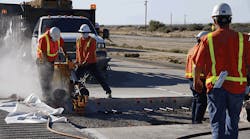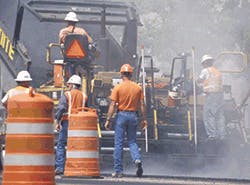Two years ago, Alan White of the United Steelworkers Local 593 testified in support of new silica standards during public hearings held by the U.S. Department of Labor.
White, who had worked at a foundry in Buffalo, N.Y. for nearly two decades, found out six years ago that he would die from exposure to silica in his workplace.
Despite his smoke-free, alcohol-free lifestyle, simple activities like walking the mile home from work became too difficult as a result of the onset of silicosis – a chronic lung disease caused by the inhalation of silica particles.
"When I got my first job at the foundry, I made more than $60,000 the first year and thought I was set. I was ready and willing to give my all to work. But I never realized that that included my life," White said during his testimony. "Now I know that my lifestyle probably won't benefit my long-term health because of the devastating effects of silica exposure."
Today, White still is working, still fighting a battle he knows he can't win against a disease brought on by unsafe work conditions.
He is not alone.
The American Lung Association estimates that 2 million U.S. workers, particularly those in mining, quarrying, sandblasting, pottery making, rock drilling, road construction, stone masonry and tunneling, are exposed to free crystalline silica dust and thus are at risk for developing silicosis.
About 100 people die from silicosis each year, according to the Centers for Disease Control and Prevention. And, while that number has decreased dramatically (85 percent) in the past 50 years, deaths among younger people (those aged 15-44) are still occurring, a trend the CDC attributes to new jobs that place workers at risk for silicosis like hydraulic fracturing, sandblasting denim and engineered stone countertop fabrication and installation.
The effects of silica dust have been known for centuries, yet it continues to be a workplace killer.
That's because the silica standards in place by OSHA were set 40 years ago and attempts to delay updates to those standards have stalled the process, said Peg Seminario, safety and health director for the AFL-CIO.
"It's still a problem because it's not controlled and it's not controlled both because the standards are out of date and aren't sufficiently protective and also are hard to oversee and enforce. It's still a problem because too many employers aren't installing safeguards," Seminario said.
However, after years and multiple attempts to set new standards, change could finally be on the horizon. OSHA as soon as early 2016 could pass new standards for worker protection from silica.
A Time for Change
The new standards proposed by OSHA – one for general industry and maritime and one for the construction industry – would set a new universal permissible exposure limit: an 8-hour time-weighted average of 50 micrograms of respirable crystalline silica per cubic meter of air. The standards, which also suggest control measures and precautions, would replace the existing standard set in 1971 that is based on calculations and differs by industry.
"It's not just limiting the amount, it's really putting in a different approach that actually helps you get controls in place," Seminario said.
With the new standards in effect, nearly 700 lives could be saved each year, OSHA estimates. And another 1,600 new cases of silicosis per year could be prevented.
"My health will not improve, but as OSHA moves forward with this silica standard other workers will be able to enjoy their time with their grandchildren," White said.
The new standards would align OSHA with the recommended exposure limit (REL) that NIOSH proposed in 1974, said Stephanie Stevens, a health communication specialist for NIOSH.
Despite the lack of formal protections, however, some industries are taking steps of their own to manage the hazard.
The Silica/Asphalt Milling Machine Partnership, for example, developed the Best Practice Engineering Control Guidelines to Control Worker Exposure to Respirable Crystalline Silica during Asphalt. The document established recommendations for the use of ventilation controls and of water sprays to help industry lower silica exposures.
"It's not as though there haven't been efforts made by some employers; there have. The voluntary efforts haven't been sufficient," Seminario said. "It's not become a widespread practice."
Instead, companies and foundries like the one from which White developed silicosis focus on "obvious safety hazards" like trips and falls, lifting, heat exposure and plant traffic.
"But they did not tell us about the unseen dangers. They never told me about silica and the health effects that breathing it can cause," White said.
Some industry groups are arguing that the new standards proposed by OSHA are too restrictive.
The Construction Industry Safety Coalition, a group of 25 national trade associations, in March said that the new standards would cost the industry $5 billion per year – 4.5 billion more than OSHA estimated – and would cut 52,700 jobs from the national economy.
Jeff Buczkiewicz, president of the Mason Contractors Association of America, said that "the current silica rule has done a fantastic job of reducing related illnesses."
"Our industry needs a rule that is based on real-world construction site scenarios that is not technologically and economically infeasible to implement," he said.
But Seminario said the AFL-CIO doesn't believe the current standards are protective and partially attributes the decline in the number of silica-related deaths to the nature of work and how workers are more transient, thus less likely to have health problems identified as silica-related.
"The [fact] that we still have so many in industry saying the current standard is fine, that we just need more enforcement, that to me is just criminal and so dishonest. It just demonstrates that there really is no interest in protecting workers," she said.

